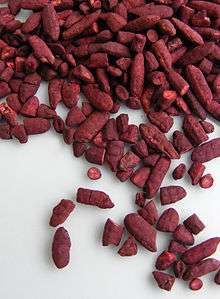Monascus purpureus
Monascus purpureus (syn. M. albidus, M. anka, M. araneosus, M. major, M. rubiginosus, and M. vini; simplified Chinese: 红曲霉; traditional Chinese: 紅麴黴; pinyin: hóng qū méi, lit. "red yeast") is a species of mold that is purplish-red in color. It is also known by the names ang-khak rice mold, corn silage mold, maize silage mold, and rice kernel discoloration.
| Monascus purpureus | |
|---|---|
 | |
| Monascus purpureus growing on white rice (red yeast rice) | |
| Scientific classification | |
| Kingdom: | |
| Division: | |
| Class: | |
| Order: | |
| Family: | |
| Genus: | |
| Species: | M. purpureus |
| Binomial name | |
| Monascus purpureus (Went, 1895) | |
Growth
During growth, Monascus spp. break down starch substrate into several metabolites, including pigments produced as secondary metabolites. The structure of pigments depends on type of substrate and other specific factors during culture, such as pH, temperature, and moisture content.[1][2]
Importance
This fungus is most important because of its use, in the form of red yeast rice, in the production of certain fermented foods in China. However, discoveries of cholesterol-lowering statins produced by the mold has prompted research into its possible medical uses. It produces a number of statins. The naturally occurring lovastatins and analogs are called monacolins K, L, J, and also occur in their hydroxyl acid forms along with dehydroxymonacolin and compactin (mevastatin). The prescription drug lovastatin, identical to monacolin K, is the principal statin produced by M. purpureus. Only the open-ring (hydroxy acid) form is pharmacologically active.[3][4][5][6]
Commercial species
The related fungi M. ruber and M. pilosus are also used in industrial applications.[7]
See also
- Aspergillus oryzae (koji)
- Fungal isolates
- List of microorganisms used in food and beverage preparation
- Medicinal molds
- Medicinal mushrooms
- Saccharomyces boulardii
- Saccharomyces cerevisiae
References
- Chiang Mai Journal of Science
- Idosi Publication
- Endo A (2004). "The origin of the statins. 2004". Atheroscler Suppl. 5 (3): 125–130. doi:10.1016/j.atherosclerosissup.2004.08.033. PMID 15531285.
- Edwards JE, Moore RA (2003). "Statins in hypercholesterolaemia: a dose-specific meta-analysis of lipid changes in randomised, double blind trials". BMC Fam Pract. 4: 18. doi:10.1186/1471-2296-4-18. PMC 317299. PMID 14969594.
- Becker DJ, Gordon RY, Morris PB, et al. (2008). "Simvastatin vs therapeutic lifestyle changes and supplements: randomized primary prevention trial". Mayo Clin. Proc. 83 (7): 758–764. doi:10.4065/83.7.758. PMID 18613992.
- Duggan, Mark; Hartman, George D (15 August 1989). "Novel HMG-CoA reductase inhibitors". US Patent and Trademark Office. Retrieved 13 January 2019.
- Panda BP, Javed S, Ali M (2010). "Production of Angkak Through Co-Culture of Monascus purpureus and Monacus ruber". Braz J Microbiol. 41 (3): 757–64. doi:10.1590/S1517-83822010000300028. PMC 3768636. PMID 24031553.
Bibhu Prasad Panda, Saleem Javed, Mohd. Ali (2010) Optimization of fermentation parameters for higher lovastatin production in red mold rice through co-culture of Monascus purpureus and Monascus ruber. Food and Bioprocess Technology, Vol. 3, no.3, 373-378
- Index Fungorum page (synonyms)
- Index Fungorum page (general)
- Monascus purpureus page
- Website about medicinal use of Monascus purpureus